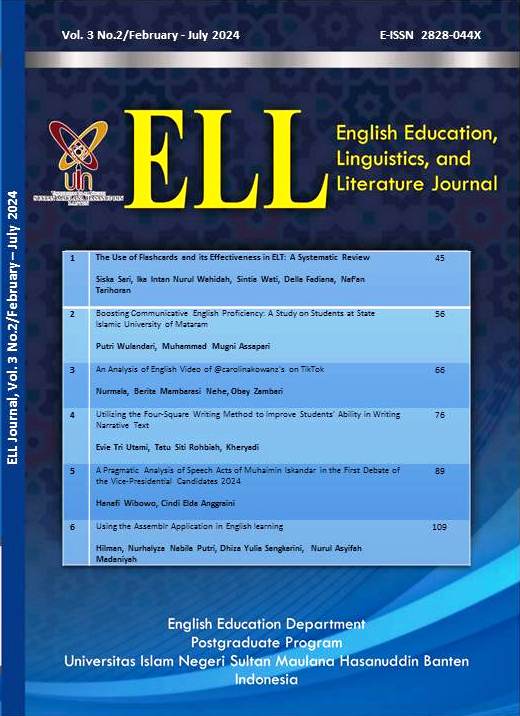Boosting Communicative English Proficiency: A Study on Students at State Islamic University of Mataram
DOI:
https://doi.org/10.32678/ell.v3i2.11001Abstract
In the field of language education, assessing students' English competency provides critical insights for effective teaching tactics and curriculum design. The goal of this paper is to assess students' English proficiency and communication skills in a specific academic setting. This qualitative study employs a descriptive approach to explore students' communicative capacities at the English Language Study Programmer, State Islamic University of Mataram, during the academic year 2023-2024. Data are gathered by observation, questionnaires, and interviews. According to the findings of this article, students in the third semester experience substantial obstacles in their English communication skills, particularly in vocabulary, grammar, pronunciation, and lack of English usage. Motivation to improve these skills is critical for student development. highlighting the importance of effective communication and the obstacles faced by students, highlighting the importance of good communication, student challenges, improvement options, and broader implications for academic and career success. English learners must have a high level of enthusiasm and confidence to acquire fluent English. To increase student involvement, English lecturers should emphasize the importance of language in today's world and use efficient teaching approaches. Future scholars should seek out fresh insights into English-speaking skills to successfully assist students and educators.
Downloads
References
Aggarwal, C. C., & Yu, P. S. (2010). On clustering massive text and categorical data streams. Knowledge and Information Systems, 24(2), 171–196. https://doi.org/10.1007/s10115-009-0241-z
Butts, M. M., Becker, W. J., & Boswell, W. R. (2015). Hot Buttons and Time Sinks: The Effects of Electronic Communication During Nonwork Time on Emotions and Work-Nonwork Conflict. Academy of Management Journal, 58(3), 763–788. https://doi.org/10.5465/amj.2014.0170
Goto-Tamura, R., Takesue, Y., & Takesue, S. (1976). Immunological similarity between NADH-cytochrome b5 reductase of erythrocytes and liver microsomes. Biochimica Et Biophysica Acta, 423(2), 293–302. https://doi.org/10.1016/0005-2728(76)90186-9
Guerrero, L. K., Andersen, P. A., & Afifi, W. A. (2018). Close encounters: Communication in relationships (Fifth edition). SAGE.
Heidari, A., Ketabi, S., & Zonoobi, R. (2014). The Role of Culture Through the Eyes of Different Approaches to and Methods of Foreign Language Teaching. Journal of Intercultural Communication, 14(1), 1–15. https://doi.org/10.36923/jicc.v14i1.667
Herdiana Abdurrahman, N. (2018). The effect of interpersonal communication skills and work motivation on performance of marketing employee. International Journal of Engineering & Technology, 7(2.29), 190. https://doi.org/10.14419/ijet.v7i2.29.13314
Kukulska‐Hulme, A., Lee, H., & Norris, L. (2017). Mobile Learning Revolution: Implications for Language Pedagogy. In C. A. Chapelle & S. Sauro (Eds.), The Handbook of Technology and Second Language Teaching and Learning (1st ed., pp. 217–233). Wiley. https://doi.org/10.1002/9781118914069.ch15
Liu, S., Gao, S., & Ji, X. (2023). Beyond borders: Exploring the impact of augmented reality on intercultural competence and L2 learning motivation in EFL learners. Frontiers in Psychology, 14, 1234905. https://doi.org/10.3389/fpsyg.2023.1234905
Methodology in language teaching: An anthology of current practice. (2010). Cambridge University Press.
Myers, K. K., & Sadaghiani, K. (2010). Millennials in the Workplace: A Communication Perspective on Millennials’ Organizational Relationships and Performance. Journal of Business and Psychology, 25(2), 225–238. https://doi.org/10.1007/s10869-010-9172-7
Patton, W., & McMahon, M. (2021). Career Development and Systems Theory: Connecting Theory and Practice (4th Edition). BRILL. https://doi.org/10.1163/9789004466210
Salvation, M. D. (2019). Communication and Conflict Resolution in the Workplace: Overcoming Barriers in Matrix Coating. Dev Sanskriti Interdisciplinary International Journal, 13, 25–46. https://doi.org/10.36018/dsiij.v13i.112
Swanson, L. H., Bianchini, J. A., & Lee, J. S. (2014). Engaging in argument and communicating information: A case study of english language learners and their science teacher in an urban high school: ENGAGING IN ARGUMENTATION AND COMMUNICATION. Journal of Research in Science Teaching, 51(1), 31–64. https://doi.org/10.1002/tea.21124
The trusted advisor (20th anniversary edition). (2021). Simon et Schuster.
Wurm, S. A., Mühlhäusler, P., & Tryon, D. T. (1996). Atlas of languages of intercultural communication in the Pacific, Asia, and the Americas. Mouton de Gruyter.
Yu, B. (2013). Issues in Bilingualism and Heritage Language Maintenance: Perspectives of Minority-Language Mothers of Children with Autism Spectrum Disorders. American Journal of Speech-Language Pathology, 22(1), 10–24. https://doi.org/10.1044/1058-0360(2012/10-0078)
Downloads
Published
Issue
Section
License
Copyright (c) 2024 Putri Wulandari, Muhammad Mugni Assapari

This work is licensed under a Creative Commons Attribution-ShareAlike 4.0 International License.






